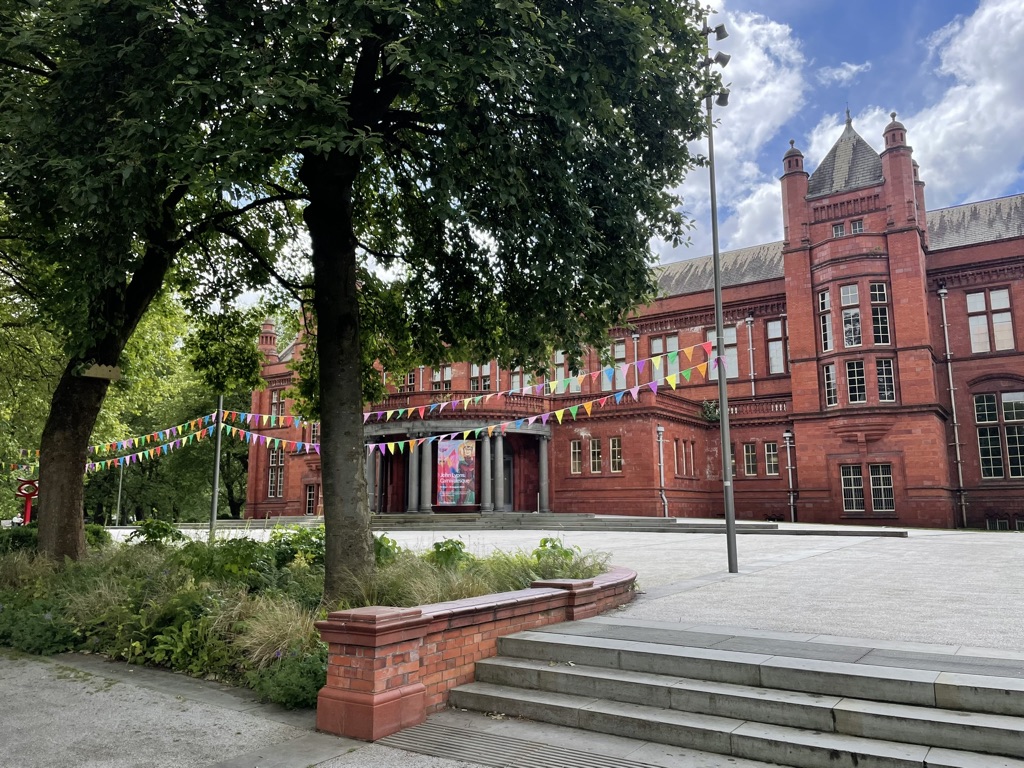Featured image: Elizabeth Clark
After stepping into the stark white gallery space of The Whitworth Art Gallery in Manchester, viewers venture blindly into the dimly lit exhibition rooms where Shirley Craven’s magnificent designs hang. Here, housed in the industrial red brick, the vibrant textile designs seem to leap off the walls, dancing and singing around unsuspecting viewers, beckoning them to absorb the vibrant colours, dynamic shapes and intricate patterns.
The exhibition displays enormous Craven-designed textiles that hang from the vertical gallery space, filling the acreage of fabrics and enabling viewers to lean over the balcony and almost touch the swirling shapes and geometric patterns.
This intimate exhibition encapsulates the refreshing nature of Craven’s designs, reminding us of the joy of being alive and offering respite from the hectic rigmarole of everyday life.
The design series Sixty-Three perfectly encapsulates the large-scale characteristics of her designs. Printed entirely by hand in several colourways, Sixty-Three cements Craven’s design identity, seeming to transport viewers into the psychedelic era of the 60s in a haze of bright colours and bold designs.
Standing here, on a rainy Thursday morning in June, Craven’s designs make it hard not to feel transported to another place entirely. Intoxicated by the swirling patterns and contrasting colours, the textiles beckon viewers to take a moment for enjoyment and self-care, creating a palpable warmth and joy from her work.
Born in Hull in 1934, Craven’s love for art and design was evident from an early age. At 12-years- old, she was awarded a scholarship to attend the Hull Junior College of Art, later progressing her studies to the Hull College of Art in 1950. While studying, she developed a passion for the Yorkshire landscape, which left a lasting impact on her studies in painting, drawing, and her initial foray into the world of textiles.
Inspired by the natural world, many of Craven’s designs draw inspiration from the desolate landscapes of the North Yorkshire Moors where she grew up, as well as the surrounding rocky coastal formations in Whitby. Aside from her home in Yorkshire, she was especially drawn to the city, finding great inspiration from the vibrant design community there.
In 1955 Craven applied to the Royal College of Art in London to study textiles. It was here that her designs began to truly flourish, capturing the attention of colleagues and piquing the interest of other designers and buyers.
Shirley Craven was involved with the printing firm Hull Traders, which drew together promising young designers to create a platform for British craftsmanship. Designs by David Whitehead, Eduardo Paolozzi and Althea McNish demonstrate the Hull Traders’ ambitious designs and radical thinking.
Craven’s designs offered an extremely forthcoming and exciting glimpse into a completely new approach to textile design. Her designs defied boundaries, breaking away from the restrictions of war and seeming to embark on a journey of re-invention. By using practical methods, Craven worked primarily with screen-printing to achieve her final designs, granting her complete control when working at a large scale.
Amid the beckoning call of exam season, the designs offer a glimpse of life in the 60s. In a kaleidoscope of bright colours and striking patterns, Shirley Craven at The Whitworth offers some much-needed light on this bleak day in June, radiating joy and hope for the past, present and future.
This article was written using research and information from the book Shirley Craven and Hull Traders: Revolutionary Fabrics and Furniture 1957-1980, available to buy online and at The Whitworth Shop.
Shirley Craven at The Whitworth Art Gallery will be on display until 11th May, 2025.






Leave a reply